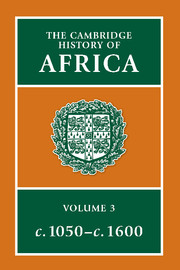Book contents
- Frontmatter
- Introduction: some interregional themes
- 1 Egypt, Nubia and the Eastern Deserts
- 2 Ethiopia, the Red Sea and the Horn
- 3 The East Coast, Madagascar and the Indian Ocean
- 4 The eastern Maghrib and the central Sudan
- 5 The western Maghrib and Sudan
- 6 Upper and Lower Guinea
- 7 Central Africa from Cameroun to the Zambezi
- 8 Southern Africa
- 9 The East African interior
- Bibliographical Essays
- Bibliography
- Index
- References
5 - The western Maghrib and Sudan
Published online by Cambridge University Press: 28 March 2008
- Frontmatter
- Introduction: some interregional themes
- 1 Egypt, Nubia and the Eastern Deserts
- 2 Ethiopia, the Red Sea and the Horn
- 3 The East Coast, Madagascar and the Indian Ocean
- 4 The eastern Maghrib and the central Sudan
- 5 The western Maghrib and Sudan
- 6 Upper and Lower Guinea
- 7 Central Africa from Cameroun to the Zambezi
- 8 Southern Africa
- 9 The East African interior
- Bibliographical Essays
- Bibliography
- Index
- References
Summary
ALMORAVIDS AND ALMOHADS TO c. 1250
During the second half of the eleventh century the Almoravids, who had emerged from the south-western Sahara, extended their conquests from Ghana in the south, and over the Maghrib to Spain in the north. Morocco, which had previously been divided among rival dynasties, was united and began to assume its own political identity. Muslim Spain, which had previously attempted to exert political influence over Morocco, now came under the rule of a Berber dynasty. It was under this union that the Muslim civilization of Spain made its greatest impact on Morocco. The western Sudan, which had previously been connected with the Maghrib by enterprising traders only, became more closely attached to the Maghrib, and not only for the relatively short period of the Almoravid occupation. Greater intensity of Islamic activity south of the Sahara and the ever-increasing trade fostered relations between the Maghrib and the western Sudan. A good illustration of the greater integration of the Muslim Occident, from the Sudan to Spain, is the group of Muslim royal tombstones dated between 1100 and 1110, which in all probability had been sculptured and inscribed in Spain, and then carried across the Sahara to be erected on the graves of two kings and a queen of Gao, who were recent converts to Islam.
About 1055, after they had forced the Sanhaja of the southern Sahara into the Almoravid movement, the spiritual leader 'Abdullāh b. Yāsin and the military commander Yahyā b. 'Umar led these nomads northwards to conquer Sijilmasa from the Maghrawa dynasty of the Zanata (for the earlier history of the Almoravids, see Volume 2).
- Type
- Chapter
- Information
- The Cambridge History of Africa , pp. 331 - 462Publisher: Cambridge University PressPrint publication year: 1977
References
- 13
- Cited by

